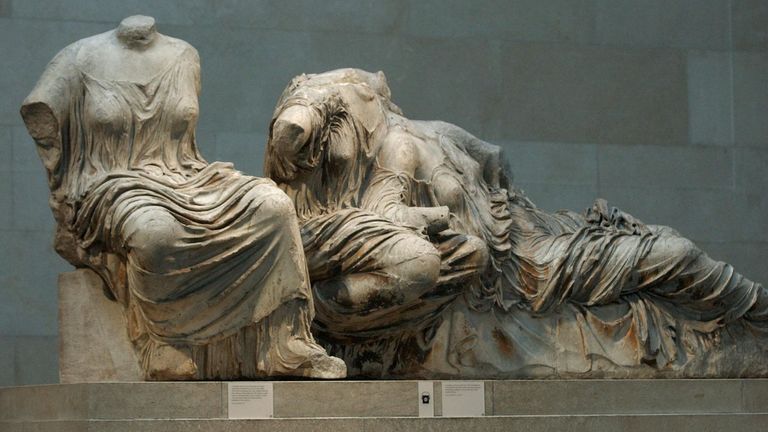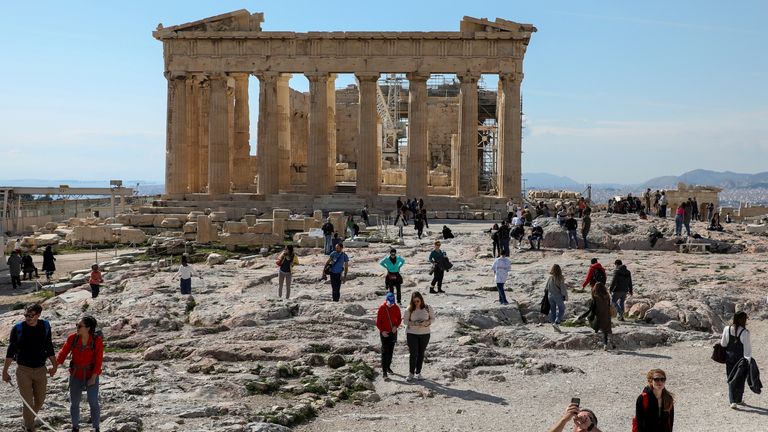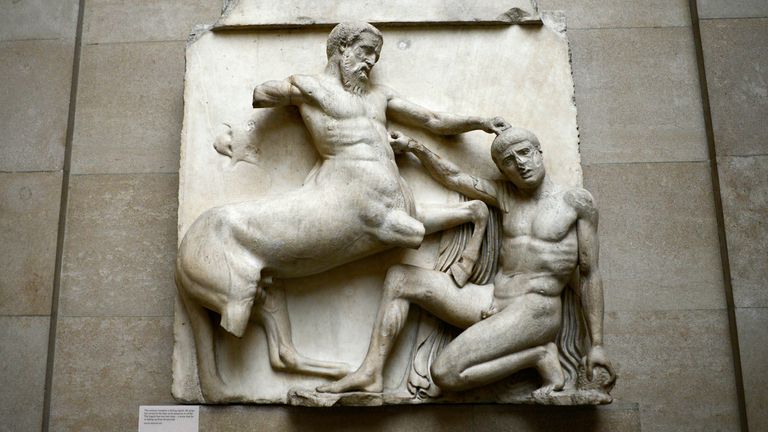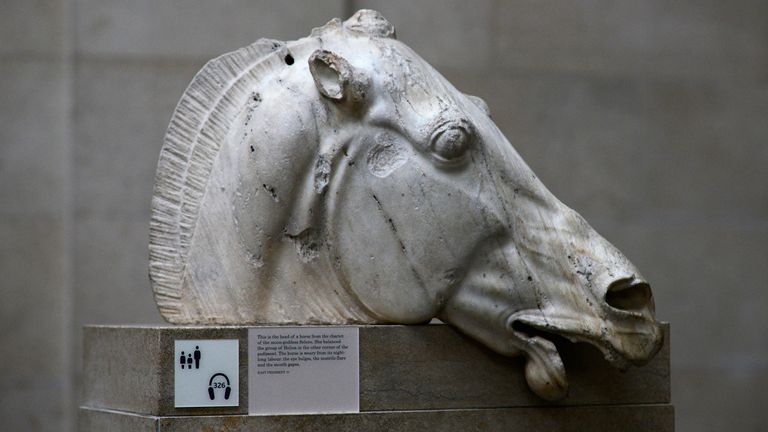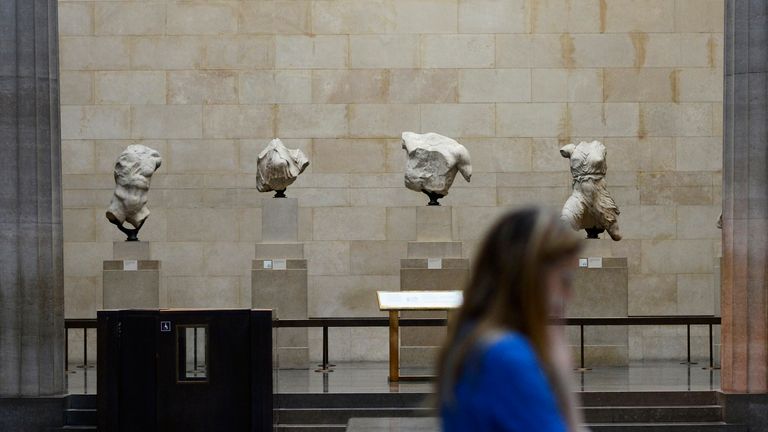Elgin Marbles: What are they and how did they end up in the British Museum?
Seen as symbols of freedom in Greece, the Parthenon Marbles were controversially removed from the country by a British diplomat in a move which ignited a debate which has lasted for more than two centuries - and which could now be about to take another significant twist.
Tuesday 28 November 2023 09:19, UK
The Elgin Marbles could soon return to Greece - more than 200 years after they were shipped out of the country to Britain.
Greece has made repeated requests for the sculptures to be returned after they were controversially removed from one of the world's most historic monuments.
Prime Minister Rishi Sunak was due to meet with his Greek counterpart Kyriakos Mitsotakis on Tuesday, but Downing Street has cancelled the arrangement, sending deputy PM Oliver Dowden instead.
Chairman of the British Museum, former Conservative chancellor George Osborne, is pushing for a temporary loan back to Greece - and is believed to have drawn up an agreement.
But both Mr Sunak and Labour leader Sir Keir Starmer say they would not support a change to the British Museum Act that currently prevents them from being returned. The museum has said it continues to have "constructive discussions" over their possible return.
What are the Elgin Marbles?
They are 17 sculptures which are 2,500 years old.
The marbles were part of a frieze that decorated the ancient Parthenon temple at the Acropolis in Athens, Greece.
The marbles made up around half of the 160-metre frieze at the Parthenon, which is regarded as one of the world's greatest cultural monuments.
The sculptures are seen as symbols of freedom in Greece, where they are known as the Parthenon Marbles.
How did they end up in Britain?
British diplomat Lord Elgin removed the sculptures from the imposing Parthenon temple in the early 19th century.
At the time, he was the ambassador to the Ottoman Empire, which then ruled Greece.
Beginning in 1801, Lord Elgin is said to have overseen the removal and shipping to the UK of the marbles in 170 crates.
He is said to have claimed he had been given permission by the Ottoman Empire for the transfer of the marbles - but despite the vast documentation from that period, nothing has been found to support his actions.
In the UK, Lord Elgin received support and criticism.
He sold them to the UK government in 1816 before the marbles were passed into the trusteeship of the British Museum.
When did the dispute begin - and how did it unfold?
The controversy can be traced back to when the marbles first arrived in Britain due to the criticism of their removal.
Then in 1832, Greece gained its independence from the Ottoman Empire before it set about trying to recover the sculptures and other artworks which had been taken from the country.
In the early 1980s, actress and then Greek minister for culture, Melina Mercouri, reignited the campaign when she made it her mission to secure the return of the marbles.
In 1983, she met the director of the British Museum, Dr David Wilson, in London demanding the sculptures be returned.
She continued to put pressure on the museum and the British government up until her death in 1994.
Despite other requests and high-profile media coverage, no deal was reached in the years that followed.
Then in 2009, Greece stepped up its campaign for the return of the marbles after opening a new museum at the foot of the Acropolis hill that it hopes will one day house them.
In 2014, human rights barrister Amal Clooney called on Britain to start talks with Greece on the return of the Elgin Marbles.
"This is an injustice that has persisted for too long, and in a world of intractable conflicts," said the lawyer, who is the wife of Hollywood star George Clooney.
In 2015, Greece ruled out taking any legal action against the UK over the Elgin Marbles.
In May 2022, the so-called Fagan fragment - a piece showing the foot of the seated ancient Greek goddess Artemis, was permanently returned to Athens from a museum in Italy.
It had originally been a part of the fifth century BC temple's eastern frieze.
What has been the reaction in the UK?
In 2022, there were calls to make it easier for UK museums to consider returning cultural objects - but these were rejected by the government.
Conservative former culture minister Lord Vaizey is also chairing a new body which aims to return the Elgin Marbles to Greece.
It comes after then-prime minister Boris Johnson told the Greek premier during talks at Downing Street in 2021 that the issue over the sculptures was "one for the trustees of the British Museum".
Then at the beginning of December, George Osborne, the chair of the British Museum, was reported to have been holding secret talks with the Greek prime minister over the possible return of the marbles.
The negotiations between the former chancellor and Kyriakos Mitsotakis have been taking place in London since November 2021, according to Greek daily newspaper Ta Nea.
The Greek prime minister has called for the sculptures to be transferred on many occasions, even offering to loan other treasures to the British Museum in exchange.
A spokesperson for the Parthenon Project, a campaign advocating for the return of the marbles, hailed the talks as a "positive sign" that a "win-win solution" to the centuries-old debate is possible.
What has been said about a possible deal?
In December, Downing Street said there were no plans to change the law which bans the museum from disposing of objects from its collection except in very limited circumstances.
The prime minister's official spokesman said: "The Parthenon sculptures are legally owned by the trustees and operationally independent of the government."
Last month, the British Museum released a statement which said it was not going to dismantle its collection "as it tells a unique story of our common humanity" - but added it wanted to forge a new "Parthenon Partnership" with Greece.
Lord Vaizey used a debate at Westminster to again press for the return of the sculptures.
He said the frieze in Athens is "like a movie that's been cut in half and half has been taken against the will of its owners to another country".
After the bilateral meeting between Mr Sunak and Mr Mitsotakis was cancelled on Monday the Greek leader said he was "disappointed".
Mr Sunak said the UK "has no plans to change our approach" but he "hasn't asked him [Mr Mitsotakis] about short-term or new ideas that have put forward".
Labour leader Sir Keir Starmer met with Mitsotakis on Monday. A source close to Labour leader Sir Keir Starmer told the Financial Times he would unlikely change the law if he wins the next election.
"We're sticking with the existing law, but if a loan deal that is mutually acceptable to the British Museum and the Greek government can be agreed, we won't stand in the way," the source told the paper.
So is a deal with Greece imminent?
George Osborne is understood to have drawn up an agreement with Athens, according to The Daily Telegraph.
The current legislation prevents treasures from being legally given away by the museum, but Mr Osborne is reportedly seeking to repatriate the antiquities as part of a long-term "cultural exchange".
But such a loan deal is not expected to permanently end the long-running dispute.
